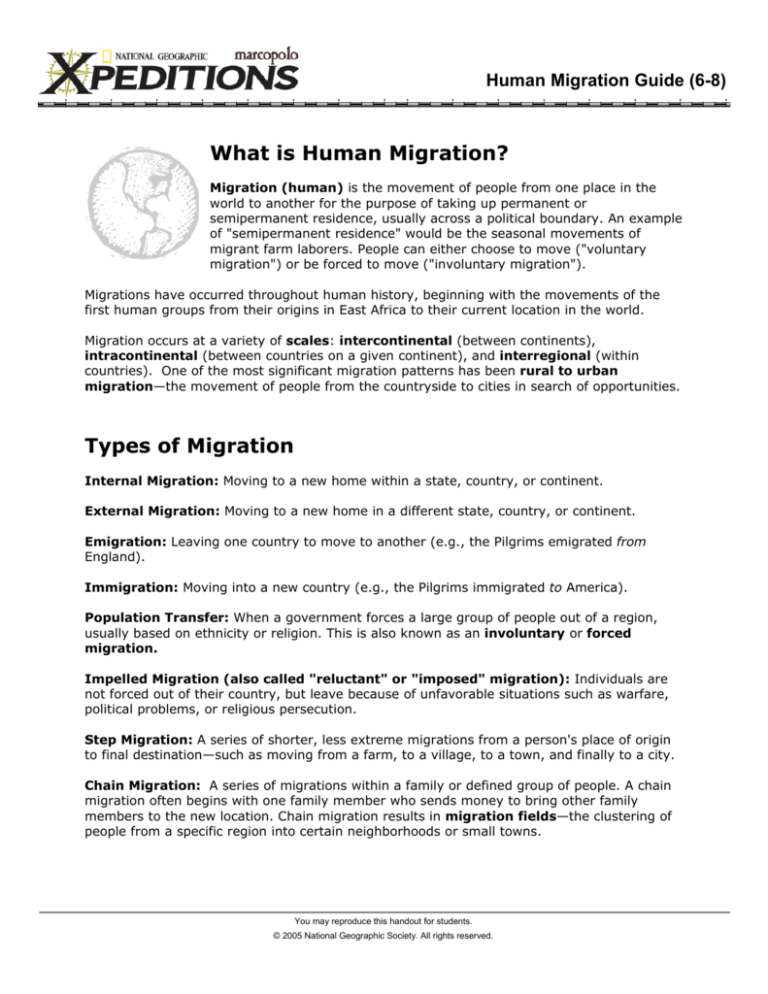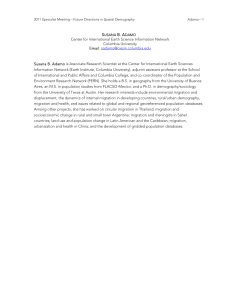
Human Migration Guide (6-8)
What is Human Migration?
Migration (human) is the movement of people from one place in the
world to another for the purpose of taking up permanent or
semipermanent residence, usually across a political boundary. An example
of "semipermanent residence" would be the seasonal movements of
migrant farm laborers. People can either choose to move ("voluntary
migration") or be forced to move ("involuntary migration").
Migrations have occurred throughout human history, beginning with the movements of the
first human groups from their origins in East Africa to their current location in the world.
Migration occurs at a variety of scales: intercontinental (between continents),
intracontinental (between countries on a given continent), and interregional (within
countries). One of the most significant migration patterns has been rural to urban
migration—the movement of people from the countryside to cities in search of opportunities.
Types of Migration
Internal Migration: Moving to a new home within a state, country, or continent.
External Migration: Moving to a new home in a different state, country, or continent.
Emigration: Leaving one country to move to another (e.g., the Pilgrims emigrated from
England).
Immigration: Moving into a new country (e.g., the Pilgrims immigrated to America).
Population Transfer: When a government forces a large group of people out of a region,
usually based on ethnicity or religion. This is also known as an involuntary or forced
migration.
Impelled Migration (also called "reluctant" or "imposed" migration): Individuals are
not forced out of their country, but leave because of unfavorable situations such as warfare,
political problems, or religious persecution.
Step Migration: A series of shorter, less extreme migrations from a person's place of origin
to final destination—such as moving from a farm, to a village, to a town, and finally to a city.
Chain Migration: A series of migrations within a family or defined group of people. A chain
migration often begins with one family member who sends money to bring other family
members to the new location. Chain migration results in migration fields—the clustering of
people from a specific region into certain neighborhoods or small towns.
You may reproduce this handout for students.
© 2005 National Geographic Society. All rights reserved.
Page 2 of 5
Human Migration Guide (6-8)
Return Migration: The voluntary movements of immigrants back to their place of origin.
This is also known as circular migration.
Seasonal Migration: The process of moving for a period of time in response to labor or
climate conditions (e.g., farm workers following crop harvests or working in cities off-season;
"snowbirds" moving to the southern and southwestern United States during winter).
People Who Migrate
Emigrant: A person who is leaving a country to reside in another.
Immigrant: A person who is entering a country from another to take up new residence.
Refugee: A person who is residing outside the country of his or her origin due to fear of
persecution for reasons of race, religion, nationality, membership in a particular social group,
or political opinion.
Internally Displaced Person (IDP): A person who is forced to leave his or her home region
because of unfavorable conditions (political, social, environmental, etc.) but does not cross
any boundaries.
Migration Stream: A group migration from a particular country, region, or city to a certain
destination.
Why Do People Migrate?
People move for a variety of reasons. They consider the advantages and disadvantages of
staying versus moving, as well as factors such as distance, travel costs, travel time, modes of
transportation, terrain, and cultural barriers.
Push Factors: Reasons for emigrating (leaving a place) because of a difficulty (such as a
food shortage, war, flood, etc.).
Pull Factors: Reasons for immigrating (moving into a place) because of something desirable
(such as a nicer climate, better food supply, freedom, etc.).
Several types of push and pull factors may influence people in their movements (sometimes
at the same time), including:
1.
2.
3.
4.
Environmental (e.g., climate, natural disasters)
Political (e.g., war)
Economic (e.g., work)
Cultural (e.g., religious freedom, education)
www.nationalgeographic.com/xpeditions
© 2005 National Geographic Society. All rights reserved.
Page 3 of 5
Human Migration Guide (6-8)
Place Utility: The desirability of a place based on its social, economic, or environmental
situation, often used to compare the value of living in different locations. An individual’s idea
of place utility may or may not reflect the actual conditions of that location.
Intervening Opportunities: Opportunities nearby are usually considered more attractive
than equal or slightly better opportunities farther away, so migrants tend to settle in a
location closer to their point of origin if other factors are equal.
Distance Decay: As distance from a given location increases, understanding of that location
decreases. People are more likely to settle in a (closer) place about which they have more
knowledge than in a (farther) place about which they know and understand little.
Laws of Migration
Geographer E.G. Ravenstein developed a series of migration 'laws' in the 1880s that form the
basis for modern migration theory. In simple language, these principles state:
•
•
•
•
•
•
•
Most migrants travel only a short distance.
Migrants traveling long distances usually settle in urban areas.
Most migration occurs in steps.
Most migration is rural to urban.
Each migration flow produces a movement in the opposite direction ("counterflow").
Most migrants are adults.
Most international migrants are young males, while more internal migrants are female.
Impacts of Migration
Human migration affects population patterns and characteristics, social and cultural patterns
and processes, economies, and physical environments. As people move, their cultural traits
and ideas diffuse along with them, creating and modifying cultural landscapes.
Diffusion: The process through which certain characteristics (e.g., cultural traits, ideas,
disease) spread over space and through time.
Relocation Diffusion: Ideas, cultural traits, etc. that move with people from one place to
another and do not remain in the point of origin.
Expansion Diffusion: Ideas, cultural traits, etc., that move with people from one place to
another but are not lost at the point of origin, such as language.
Cultural markers: Structures or artifacts (e.g., buildings, spiritual places, architectural
styles, signs, etc.) that reflect the cultures and histories of those who constructed or occupy
them.
www.nationalgeographic.com/xpeditions
© 2005 National Geographic Society. All rights reserved.
Page 4 of 5
Human Migration Guide (6-8)
Measuring Migration
In-migration: people moving into one place from another place within a nation (internal
migration).
Out-migration: people moving out of one place to another place within a nation (internal
migration).
Gross migration: total number of in-migrants and out-migrants (internal migration).
Net internal migration: the difference between in-migration and out-migration.
Movers from abroad: people coming into a nation from another country or part of the
world.
Net migration: the difference between net internal migration and movers from abroad.
Migrations Resources
U.S. Census Bureau
http://www.census.gov/
Population Reference Bureau
http://www.prb.org/Content/NavigationMenu/PRB/Educators/Human_Population/Migration2/M
igration1.htm
CSISS Classics: Ernest George Ravenstein—The Laws of Migration, 1885
http://www.csiss.org/classics/content/90
Ancestry.com: Thirteen Reasons Our Ancestors Migrated
http://www.ancestry.com/learn/library/article.aspx?article=1436
AngliaCampus: Migration
http://www.angliacampus.com/public/sec/geog/migrate/index.htm
RevisionNotes.Co.UK: Migration
http://www.revision-notes.co.uk/revision/171.html
Smithsonian Institution: Migrations in History
http://smithsonianeducation.org/migrations/start.html
Migration Information Source
http://www.migrationinformation.org/
UNHCR: The UN Refugee Agency
http://www.unhcr.ch/cgi-bin/texis/vtx/home
www.nationalgeographic.com/xpeditions
© 2005 National Geographic Society. All rights reserved.
Page 5 of 5
Human Migration Guide (6-8)
International Organization for Migration
http://www.iom.int/
Migration Dialogue
http://migration.ucdavis.edu/index.php
Netherlands Interdisciplinary Demographic Institute (NIDI)/EuroStat: Push and Pull Factors of
International Migration
http://www.nidi.knaw.nl/web/html/pushpull/index.html
National Geographic Magazine: Changing America
http://www7.nationalgeographic.com/ngm/data/2001/09/01/html/ft_20010901.3.html
National Geographic: Xpeditions—Geography Standard 9 - The Characteristics, Distribution,
and Migration of Human Population on Earth’s Surface
http://www.nationalgeographic.com/xpeditions/standards/09/index.html
National Geographic: Xpeditions—Migration Station
http://www.nationalgeographic.com/xpeditions/hall/index.html?node=36
National Geographic: Geography Action!—Migration: The Human Journey
http://ngsednet.org/community/index.cfm?community_id=7
National Geographic: The Genographic Project
http://www.nationalgeographic.com/genographic/index.html
National Geographic: Xpeditions—Migration: Why People Move
http://www.nationalgeographic.com/xpeditions/lessons/09/g68/tgmigration.html
www.nationalgeographic.com/xpeditions
© 2005 National Geographic Society. All rights reserved.






